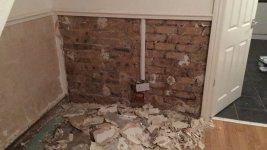Ok so I’ve been doing a ton of research on this subject and found two different answers. I have just moved into a house I’ve just bought and there was suspected rising damp.... There was no obvious damp or mould on plaster just the salts on top of finished paint surface and causing paint flake. This is on lower levels on 3 walls. Two other walls had a terrible plastering job on them so peeled them back. One has the browning behind and solid and intact but before I took plaster skim off salts came through that wall. The second I have completely took back to brick because it was the wall on the back of the bathroom and I’m suspecting leaking water from bathroom before new bathroom was refitted to sell. Bricks on that wall are bone dry and no leaks obvious anymore...
Now with the salt issue I’m going to try neutralising it with acid and surfactant mix and see if that fixes it in the good walls... but in regards to the walls that now need plastering again, is this limelite brand just a con? Is there a simpler way to plaster the bare brick wall and over the browning whilst also letting the wall ‘breathe’. I am in no way a plasterer by trade and don’t know much about this. Someone said use limlite and another said would be ok just doing a sand and cement mix onto brick and then dab and finish...
I’d like to know what the best system would be or what I can do to prevent salts and damp getting through my finished walls. Thanks
Now with the salt issue I’m going to try neutralising it with acid and surfactant mix and see if that fixes it in the good walls... but in regards to the walls that now need plastering again, is this limelite brand just a con? Is there a simpler way to plaster the bare brick wall and over the browning whilst also letting the wall ‘breathe’. I am in no way a plasterer by trade and don’t know much about this. Someone said use limlite and another said would be ok just doing a sand and cement mix onto brick and then dab and finish...
I’d like to know what the best system would be or what I can do to prevent salts and damp getting through my finished walls. Thanks



